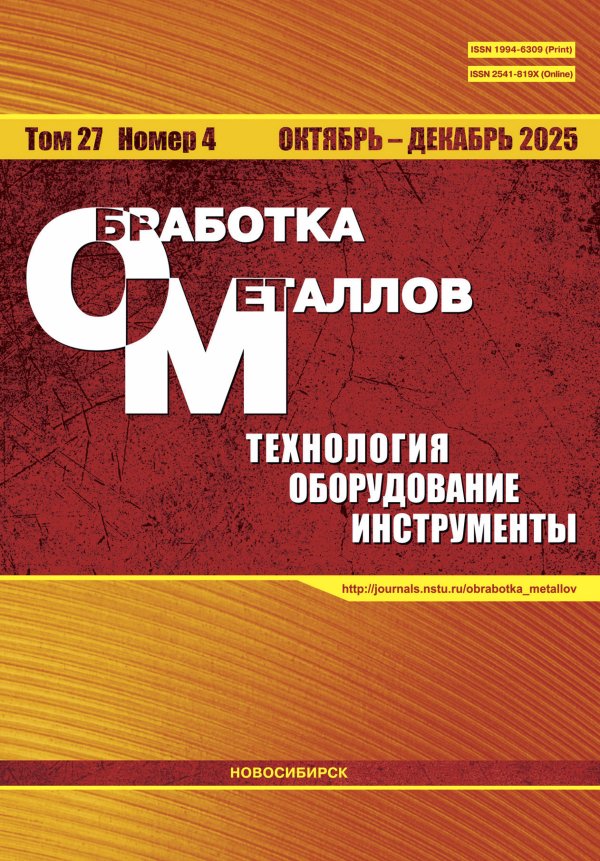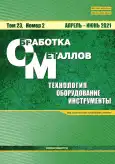Оценка влияния скорости реакции термодинамической подсистемы на динамику процесса резания при металлообработке
- Авторы: Лапшин В.П.1, Русановский Р.В.1, Туркин И.А.1
-
Учреждения:
- Выпуск: Том 23, № 2 (2021)
- Страницы: 17-30
- Раздел: ТЕХНОЛОГИЯ
- URL: https://bakhtiniada.ru/1994-6309/article/view/301937
- DOI: https://doi.org/10.17212/1994-6309-2021-23.2-17-30
- ID: 301937
Цитировать
Аннотация
Ключевые слова
Об авторах
В. П. Лапшин
Email: Lapshin1917@yandex.ru
канд. техн.наук, доцент, Донской государственный технический университет, пл. Гагарина, 1, г. Ростов-на-Дону, 344000, Россия, Lapshin1917@yandex.ru
Р. В. Русановский
Email: zames161@yandex.ru
Донской государственный технический университет, пл. Гагарина, 1, г. Ростов-на-Дону, 344000, Россия, zames161@yandex.ru
И. А. Туркин
Email: tur805@mail.ru
канд. техн. наук, Донской государственный технический университет, пл. Гагарина, 1, г. Ростов-на-Дону, 344000, Россия, tur805@mail.ru
Список литературы
- Grabec I. Chaos generated by the cutting process // Physics Letter A. – 1986. – Vol. 117, N 8. – P. 384–386. – doi: 10.1016/0375-9601(86)90003-4.
- Лапшин В.П., Тюняев Р.А., Христофорова В.В. Оценка влияния скорости подачи, на равновесные режимы привода обеспечивающего фрезерование заготовки переменной толщины // Динамика технических систем, ДТС-2015: ХII международная научно-техническая конференция. – Ростов н/Д., 2016. – С. 180–184.
- Резников А.Н., Резников Л.А. Тепловые процессы в технологических системах. – М.: Машиностроение, 1990. – 288 с.
- Рыжкин А.А. Теплофизические процессы при изнашивании инструментальных режущих материалов. – Ростов н/Д.: Изд. центр ДГТУ, 2005. – 311 с. – ISBN 5-7890-0348-6.
- Tool wear detection and fault diagnosis based on cutting force monitoring / S.N. Huang, K.K. Tan, Y.S. Wong, C.W. De Silva, H.L. Goh, W.W. Tan // International Journal of Machine Tools and Manufacture. – 2007. – Vol. 47, iss. 3–4. – P. 444–451.
- Tool condition monitoring in turning using statistical parameters of vibration signal / H. Arslan, A.O. Er, S. Orhan, E. Aslan // International Journal of Acoustics and Vibration. – 2016. – Vol. 21, iss. 4. – P. 371–378.
- Alonso F.J., Salgado D.R. Application of singular spectrum analysis to tool wear detection using sound signals // Proceedings of the Institution of Mechanical Engineers, Part B: Journal of Engineering Manufacture. – 2005. – Vol. 219 (9). – P. 703–710.
- Dimla Sr D.E., Lister P.M. On-line metal cutting tool condition monitoring. I: force and vibration analyses // International Journal of Machine Tools and Manufacture. – 2000. – Vol. 40 (5). – P. 739–768. – doi: 10.1016/S0890-6955(99)00084-X.
- Tool wear evaluation by vibration analysis during end milling of AISI D3 cold work tool steel with 35 HRC hardness / S. Orhan, A.O. Er, N. Camuscu, E. Aslan // NDT & E International. – 2007. – Vol. 40 (2). – P. 121–126.
- Tobias S.A. Vibraciones en máquinas-herramientas. – Bilboa, Spain: Ediciones Urmo, 1961.
- Sri Namachchivaya, Beddini. Spindle speed variation for the suppression of regenerative chatter // Journal of Nonlinear Science. – 2003. – Vol. 13, N 3. – P. 265–288. – doi: 10.1007/s00332-003-0518-4.
- Wahi P., Chatterjee A. Regenerative tool chatter near a codimension 2 Hopf point using multiple scales // Nonlinear Dynamics. – 2005. – Vol. 40, N 4. – P. 323–338.
- Stépán G., Insperger T., Szalai R. Delay, parametric excitation, and the nonlinear dynamics of cutting processes // International Journal of Bifurcation and Chaos. – 2005. – Vol. 15, N 09. – P. 2783–2798. – doi: 10.1142/S0218127405013642.
- Nonlinear behaviour of the regenerative chatter in turning process with a worn tool: forced oscillation and stability analysis / H. Moradi, F. Bakhtiari-Nejad, M.R. Movahhedy, M.T. Ahmadian // Mechanism and Machine Theory. – 2010. – Vol. 45, N 8. – P. 1050–1066. – doi: 10.1016/j.mechmachtheory.2010.03.014.
- Nonlinear dynamics of a machining system with two interdependent delays / A.M. Gouskov, S.A. Voronov, H. Paris, S.A. Batzer // Communications in Nonlinear Science and Numerical Simulation. – 2002. – Vol. 7, N 4. – P. 207–221. – doi: 10.1016/S1007-5704(02)00014-X.
- Hahn R.S. On the theory of regenerative chatter in precision grinding operation // Transactions of American Society of Mechanical Engineers. – 1954. – Vol. 76. – P. 356–260.
- Tobias S.A., Fishwick W. Theory of regenerative machine tool chatter // The Engineer. – 1958. – Vol. 205, N 7. – P. 199–203.
- Merritt H.E. Theory of self-excited machine-tool chatter: contribution to machine-tool chatter research // Journal of Engineering for Industry. – 1965. – Vol. 87. – P. 447–454. – doi: 10.1115/1.3670861.
- Balachandran B. Nonlinear dynamics of milling process // Philosophical Transactions of The Royal Society A: Mathematical Physical and Engineering Sciences. – 2001. – Vol. 359 (1781). – P. 793–819.
- Stepan G. Modelling nonlinear regenerative e?ects in metal cutting // Philosophical Transactions of The Royal Society A: Mathematical Physical and Engineering Sciences. – 2001. – Vol. 359. – P. 739–757. – doi: 10.1098/rsta.2000.07537.
- Litak G. Chaotic vibrations in a regenerative cutting process // Chaos Solitons and Fractals. – 2002. – Vol. 13. – P. 1531–1535. – doi: 10.1016/S0960-0779(01)00176-X.
- Гуськов А.М., Воронов С.А., Квашнин А.С. Влияние крутильных колебаний на процесс вибросверления // Вестник МГТУ им. Н.Э. Баумана. Серия: Машиностроение. – 2007. – № 1 (66). – С. 3–19.
- Васин С.А., Васин Л.А. Синергетический подход к описанию природы возникновения и развития автоколебаний при точении // Наукоемкие технологии в машиностроении. – 2012. – № 1. – С. 11–16.
- Воронин А.А. Влияние ультразвуковых колебаний на процесс резания жаропрочных сплавов // Станки и инструмент. – 1960. – № 11. – С. 15–18.
- Bifurcation of stationary manifolds formed in the neighborhood of the equilibrium in a dynamic system of cutting / V.L. Zakovorotny, A.D. Lukyanov, A.A. Gubanova, V.V. Khristoforova // Journal of Sound and Vibration. – 2016. – Vol. 368. – P. 174–190. – DOI: 10.1016/j. jsv.2016.01.020.
- Zakovorotny V.L., Lapshin V.P., Babenko T.S. Modeling of tool wear: irreversible energy transformations // Russian Engineering Research. – 2018. – Vol. 38, N 9. – P. 707–708.
- Жарков И.Г. Вибрации при обработке лезвийным инструментом. – Л.: Машиностроение, 1986. – 184 с.
- Марков А.И. Ультразвуковое резание труднообрабатываемых материалов. – М.: Машиностроение, 1968. – 367 с.
- Макаров А.Д. Оптимизация процессов резания. – М.: Машиностроение, 1976. – 278 с.
- Заковоротный В.Л., Флек М.Б. Динамика процесса резания. Синергетический подход. – Ростов н/Д.: Терра, 2006. – 880 c. – ISBN 5-98254-055-2.
- Рыжкин А.А. Синергетика изнашивания инструментальных режущих материалов (трибоэлектрический аспект). – Ростов н/Д.: Изд. центр ДГТУ, 2004. – 323 с. – ISBN 5-7890-0307-9.
- Influence of the temperature in the tool–workpiece contact zone on the deformational dynamics in turning / V.P. Lapshin, I.A. Turkin, V.V. Khristoforova, T.S. Babenko // Russian Engineering Research. – 2020. – Vol. 40, N3. – P. 259–265.
- Бордачев Е.В., Лапшин В.П. Математическое моделирование температуры в зоне контакта инструмента и изделия при токарной обработке металлов // Вестник Донского государственного технического университета. – 2019. – Т. 19, № 2. – С. 130–137. – doi: 10.23047/1992-5980-2019-19-2-130-137.
- Лапшин В.П., Христофорова В.В., Носачев С.В. Взаимосвязь температуры и силы резания с износом и вибрациями инструмента при токарной обработке металлов // Обработка металлов (технология, оборудование, инструменты). – 2020. – Т. 22, № 3. – С. 44–58. – doi: 10.17212/1994-6309-2020-22.3-44-58.
Дополнительные файлы







